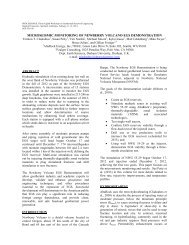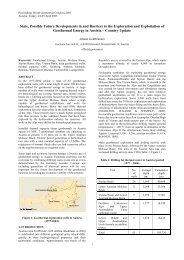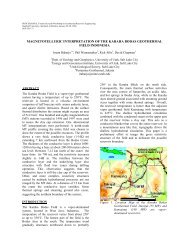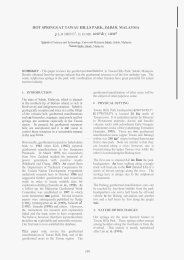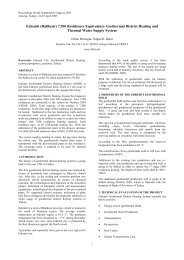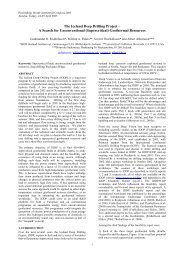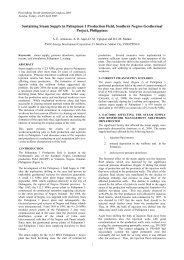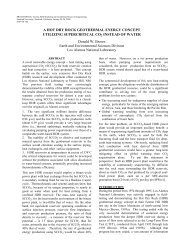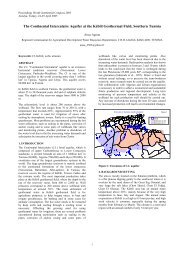Assessing Uncertainty in Future Pressure Changes Predicted By ...
Assessing Uncertainty in Future Pressure Changes Predicted By ...
Assessing Uncertainty in Future Pressure Changes Predicted By ...
Create successful ePaper yourself
Turn your PDF publications into a flip-book with our unique Google optimized e-Paper software.
<strong>Pressure</strong> change @ 45 year, bar<br />
18<br />
17<br />
16<br />
15<br />
14<br />
13<br />
12<br />
11<br />
10<br />
True<br />
2-tank closed 2-tank open 3-tank closed<br />
Figure 6. Box-and-whisker plot of predicted future<br />
pressure changes generated by RML for<br />
the three different lumped-parameter<br />
models, at the 45 th year.<br />
We should note that based on the results and<br />
methodology given <strong>in</strong> this study, it is unclear to us<br />
whether the methodology of Axelsson et al. (2005)<br />
who propose only two realizations of predictions; one<br />
with an open and the another with a closed lumpedparameter<br />
model, can provide the assessment of the<br />
<strong>in</strong>herent uncerta<strong>in</strong>ty <strong>in</strong> future pressure changes. In<br />
addition, it is unclear to us whether the future<br />
prediction changes can be expected to lie somewhere<br />
between the predictions of open and closed models,<br />
as they claim. To <strong>in</strong>vestigate this, we generated three<br />
predictions of future pressure changes based on the<br />
parameter estimates obta<strong>in</strong>ed by history-match<strong>in</strong>g of<br />
the observed data set yobs (shown as circular data<br />
po<strong>in</strong>ts <strong>in</strong> Fig. 2) with the two-tank closed and open<br />
models and three-tank open model (see Table 1 for<br />
the estimated parameters). These future predictions,<br />
<strong>in</strong> comparison with the true prediction, are shown <strong>in</strong><br />
Fig. 7. As is clear from Fig. 7, the true prediction is<br />
not conta<strong>in</strong>ed with<strong>in</strong> these predictions nor can the<br />
uncerta<strong>in</strong>ty <strong>in</strong> predictions be properly characterized<br />
because measurement errors <strong>in</strong> observed data are not<br />
accounted for <strong>in</strong> their methodology.<br />
The results of this example clearly <strong>in</strong>dicates that one<br />
can only characterize the uncerta<strong>in</strong>ty <strong>in</strong> performance<br />
predictions correctly by the most appropriate lumpedmodel<br />
representative of the geothermal system <strong>in</strong><br />
question. Identify<strong>in</strong>g the most appropriate model to<br />
be used for generat<strong>in</strong>g appropriate realizations of the<br />
future performance by the RML method may be<br />
achieved if one <strong>in</strong>spects both the RMS and<br />
confidence <strong>in</strong>tervals dur<strong>in</strong>g the history-match<strong>in</strong>g<br />
period by consider<strong>in</strong>g several candidate lumpedmodels.<br />
<strong>Pressure</strong> change, bar<br />
20<br />
18<br />
16<br />
14<br />
12<br />
10<br />
8<br />
6<br />
4<br />
2<br />
0<br />
prediction (two-tank closed)<br />
prediction (two-tank open)<br />
prediction (three-tank closed)<br />
true (two-tank open)<br />
0 5 10 15 20 25 30 35 40 45<br />
Year<br />
Figure 7. A comparison of predictions of future<br />
pressure changes based on estimated<br />
model parameters obta<strong>in</strong>ed from history<br />
match<strong>in</strong>g of the observed data with the<br />
two-tank closed and open models and<br />
three-tank closed model.<br />
CONCLUSIONS<br />
On the basis of this study, the follow<strong>in</strong>g specific<br />
conclusions can be stated:<br />
(i) A s<strong>in</strong>gle realization of the predicted response to<br />
a given production scenario is not sufficient to<br />
make reservoir management decisions that<br />
account for an <strong>in</strong>complete knowledge of the<br />
actual geothermal system.<br />
(ii) One needs to generate a multiple of realizations<br />
of the predicted future pressure changes to a<br />
given production scenario for assess<strong>in</strong>g the<br />
uncerta<strong>in</strong>ty <strong>in</strong>herent <strong>in</strong> performance predictions<br />
due to noise <strong>in</strong> observed data. The RML method<br />
can be used for this purpose.<br />
(iii) One can correctly characterize the uncerta<strong>in</strong>ty <strong>in</strong><br />
performance predictions if and only if the<br />
lumped-parameter model chosen is correct. The<br />
most appropriate lumped-model for given<br />
observed data should be identified by <strong>in</strong>spect<strong>in</strong>g<br />
both the RMS and the confidence <strong>in</strong>tervals for<br />
the estimated model parameters from history<br />
match<strong>in</strong>g with several candidate lumpedparameter<br />
models.<br />
(iv) Us<strong>in</strong>g a less parameterized lumped-parameter<br />
model for predictions gives biased predictions<br />
and highly underestimates the uncerta<strong>in</strong>ty <strong>in</strong><br />
future predictions, while us<strong>in</strong>g an overparameterized<br />
lumped-parameter model gives<br />
unbiased predictions, but overestimates the<br />
uncerta<strong>in</strong>ty <strong>in</strong> future predictions.



